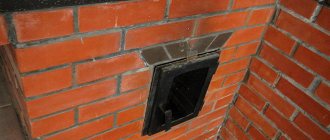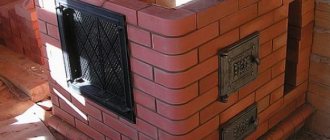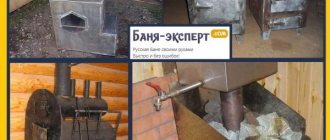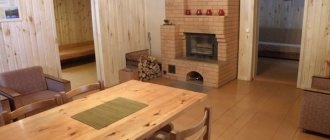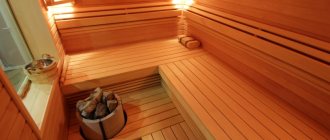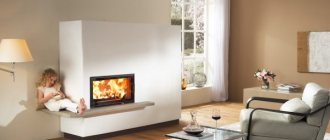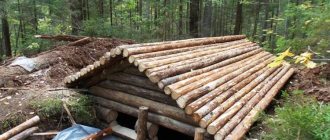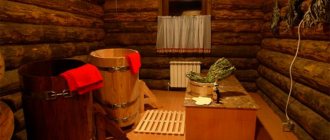The quality of bath procedures directly depends on how well the steam room is heated. And if with electric or gas stoves everything is simple - just follow the manufacturer’s recommendations exactly, then with wood-burning heaters things are much more complicated. After all, not every novice lover of light steam knows how to properly light a wood-burning sauna.
Beginners can spend hours putting wood in the firebox and be upset that the steam room does not warm up to the desired temperature. Some people forget about gate valves. And then the steam room is filled with toxic carbon monoxide, which is dangerous to the health of people steaming. How to properly heat a sauna and avoid such mistakes? Let's figure it out.
The first thing you should pay attention to is the type and quality of fuel. Preference should be given to hardwood: maple, elm or birch. Of course, you can use logs from other species. But some may be too expensive (for example, oak, hornbeam or ash), and the wood of others may have low calorific value (poplar, coniferous and fruit trees).
Another important characteristic of fuel for a wood-burning stove is humidity: the lower this indicator, the faster the steam room will warm up. Firewood with a moisture content of no more than 20% is considered ideal. The wood from a freshly cut tree is too wet. It takes a long time to flare up, burns poorly and therefore needs to be dried.
When answering the question: “How to light a stove in a bath?”, it is important to understand what materials are not recommended to be used:
- Old boards. When such fuel burns, an unpleasant odor may be released, so you will not be able to enjoy the aroma of burning logs.
- Rotten logs. They burn poorly, produce insufficient heat, and upon complete combustion they form a huge amount of ash.
- Wood that is painted or impregnated with chemicals, since burning may release toxic substances that are hazardous to human health.
- Logs with knots because they burn unevenly. You will have to either periodically rake the knots out of the firebox or add wood chips to ensure that the knots burn completely.
- Young oak bark. This material has low heat transfer.
- Firewood made from coniferous wood. Their wood has low heat transfer. In addition, combustion produces a lot of soot, which clogs the chimney system and settles on bath stones.
Please note that different types of wood have different calorific values:
And here is how the calorific value changes depending on the air humidity in the room:
Remember: only wood can be used to heat the steam room! Do not place plastic objects or old clothes in the heater's combustion chamber. When burned, they can also produce toxic smoke.
Preparing to fire a sauna with wood
Preparation begins with collecting firewood. There are also many nuances in this matter, but they will be discussed below. If we omit this aspect, then the start of the process is cleaning the room. This is a necessary condition that will allow you to light the sauna stove with the least effort, while avoiding problems with fire.
Steam room preparation
Starting preparation consists of:
- removal of foreign objects;
- dry and wet cleaning of the premises;
- thoroughly ventilate the room - it is recommended to open doors and windows.
Do not neglect regular treatment of the steam room with an antiseptic. Wood needs protection - this will increase the life of wooden trim and objects.
The sauna stove must be in correct condition. The comfort and safety of vacationers depends on how well the stove is prepared. A clogged chimney can allow carbon monoxide to enter the steam room.
Scheme for preparing the furnace:
- clean the ash pit and grate from coals and ash;
- wash the stones;
- check traction; to do this, open the ash and firebox doors and the smoke damper; after that, bring a lit match to the firebox - if the flame is drawn inward, the draft is working; an even flame indicates a clogged chimney, which in this case will definitely have to be cleaned.
If you have a boiler, check for water in it. Even if no one uses the water, without it the boiler will burst from the high temperature.
The preparatory work is done, the draft is in order - you can start lighting the stove.
To properly heat the sauna, you need to periodically “feed” the firebox with firewood. The first replenishment is approximately 15 minutes after the “seed”. Open the oven door and use a poker to smooth out any remaining solid fuel. After this, evenly lay a portion of the firewood - leave about a third of the firebox free.
It is advisable to place the firewood closer to the damper, but not close to it. The minimum distance increases heat transfer and reduces the time for full heating of the steam room. However, contact of fuel with the door can lead to unpleasant consequences.
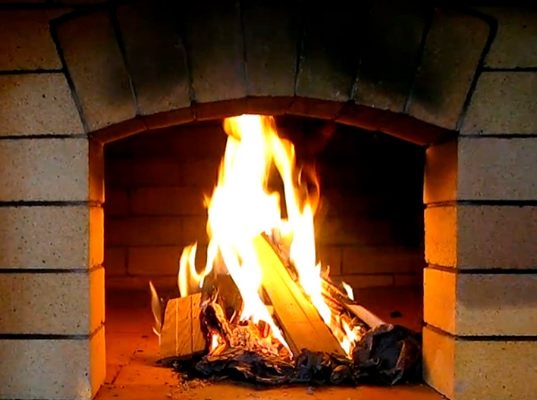
The next toss of logs is in an hour and a half. The frequency depends on the type of wood and your skill. Ideally, the intervals should be as large as possible, but without losses in heat transfer. Within a few hours the room warms up. After this, the chimney valve can be slightly closed - this will give a small saving in firewood.
In summer, lighting a bathhouse takes 3-4 hours. In winter, the process takes up to 5-6 hours. When the heating procedure is over, it is necessary to open the firebox damper and check the latter for the presence of carbon monoxide; if blue tongues of fire are dancing over the coals, there are problems - this means that after the bath procedures you will need to clean the chimney; if everything is in order, then you need to close the vent, firebox and chimney.
The kindling is finished, but this is not the end yet. After warming up, the room needs to be ventilated again. Open the window and doors for 10-15 minutes. After saturating the room with fresh air, close the doors, but do not touch the window. Let the bath brew - a couple of hours will be enough for this.
During this time, the room will not have time to cool down, but the heat will become uniform and soft, and the steam will become light. All that remains is to close the window and begin the most enjoyable part - the bath procedures.
To speed up the process, do not water the stones. This will lead to the formation of steam, but will not give the desired effect. The stones are sprinkled during the sauna relaxation process.
The choice of firewood affects the speed and quality of kindling, as well as the budget for bathing procedures. Forget about:
- rotten logs - they produce a lot of ash, but burn poorly and provide little heat;
- old firewood - their combustion is accompanied by unpleasant odors;
- firewood impregnated with chemical compounds - these emit harmful substances.
It is better to prefer firewood from hardwoods - oak, hornbeam, maple, ash. They are characterized by the greatest heat transfer. In this parameter, fruit trees are inferior to those mentioned, although they also burn well. Larch has even lower heat transfer, but is most often used for heating. This is due to the availability of such fuel.
We suggest you read: How to glue tiles to a wooden wall
It is not recommended to use firewood from pine needles. Pine and spruce produce relatively little heat, and they also release resin during combustion. The latter settle on stones and in the chimney.
In addition to heat transfer, you need to look at the moisture content of the wood. “Fresh” firewood is characterized by a humidity coefficient in the range of 35-50%. This is a lot - such logs burn poorly. The indicator should not exceed 20% - in this case the required effect is ensured.
| Tree species | Advantages and disadvantages of firewood |
| Aspen | Pros:
Minuses:
|
| Alder | Pros:
There are no cons. |
| Spruce | Pros:
Minuses:
|
| Oak | Pros:
Minus: |
| Birch | Pros:
There are no downsides, except for slightly lower heat dissipation than some other options. |
Calorific values are shown in the illustrations.
Choosing firewood
Firewood and a stove are the pillars on which a good bathhouse stands. And, if an unusable stove can only be broken in order to be rebuilt, then unusable firewood can always be replaced. What kind of firewood should you avoid?
“Yes, we don’t need this kind of hockey!” exclaimed legendary sports commentator Nikolai Ozerov, when Canadian professionals frantically began beating Soviet amateurs. Any self-respecting stoker has the right to say exactly the same phrase when he sees such firewood, before lighting the bathhouse:
- Railway sleepers. When dismantling and repairing railway tracks, a lot of free firewood often appears, which, greedy for free compatriots, happily drag to their native lands. Sleepers, poles and other elements of the industrial landscape are treated with protective compounds that prevent them from rotting. Burning them in a furnace leads to the sublimation of such substances and their combustion products into the internal atmosphere of the steam room, which is very fraught. Even deaths were recorded;
- Boards with traces of paintwork. The reason is the same;
- Wood with signs of destruction by fungi, the so-called rotten wood. In this case, you won’t be able to swallow chemical filth, but there will be little benefit from burning such raw materials. Wood that has been subjected to destruction by fungi and parasites greatly loses its caloric content and it is better to use suitable firewood than to heat the stove with dust, even if it is free.
Due to a number of features, the following types of wood are not entirely suitable:
- Spruce is a low-calorie fuel. With an equal volume of burned raw materials, less heat is released. Due to the high resin content, a large amount of soot is released during combustion;
- Pine - gives a high, light, but low-temperature flame. They burn out quickly and do not retain heat well. Tendency to shoot coals, which requires increased attention to avoid fire in the furnace flue space. To a lesser extent, but also clogs chimneys with soot and tar deposits;
- Poplar and aspen are lightweight firewood that produces a long flame that burns well through chimneys, but is low in calories and does not retain heat well. When constantly used to fire a stove, conifer wood must be used to clean chimneys naturally, using the power of flame.
What we need
This includes firewood of the highest quality category. It is with these that it is most pleasant to decide how to properly flood a bathhouse:
- Alder is “royal” firewood. Produces a dense, clean, consistent flame. Fully high-calorie wood, quite acceptable in terms of labor costs for manual firewood harvesting;
- Oak and ash are very valuable woods that, when burned, give off a characteristic and unique spicy aroma. High-calorie firewood that retains heat perfectly. They burn long enough and evenly. Oak splits perfectly along the grain, producing dies of standard size. They are expensive due to the value of the wood. It is possible to use wood processing waste;
- Birch is probably the best option for solving the question of how to heat a bathhouse. They provide high-calorie and high-quality fuel raw materials. When using woodworking waste, birch bark should be used with caution, due to the increased release of volatile resins deposited on the walls of chimneys. With relative cheapness and accessibility, a true classic of the genre in the making;
- Fruit firewood - like any other hardwood, produces high-quality firewood, distinguished, among other things, by a subtle spicy aroma when burned. Quite expensive. In addition, some tree species are highly durable and knotty, which makes harvesting firewood in significant volumes quite a fun process in all respects.
We invite you to familiarize yourself with the bathhouse made of polystyrene concrete, the pros and cons
Interpretation in various dream books: Miller, Vanga, Freud, Hasse, Tsvetkov
When deciphering your dream, you should rely on the experience you have already gained in life. If you previously had a presentiment of a feeling of approaching success and inspiration after a dream you saw and the subsequent receipt of what you wanted, then try to describe your dream based on the emotions you experienced. Often the bathhouse itself is characterized by something warm, clean and carries a bright meaning. If you were uncomfortable, cold or too hot, then think about what events could contribute to your subconscious to warn you from trouble.
Miller's Dream Book - a big journey awaits you
- Seeing how you heat the stove red-hot symbolizes a quick journey and meeting many interesting people.
- If in such a dream you are steaming, waving hot air with a broom, then great luck awaits you on the way to achieving your goal.
- The flame slipping out of the furnace doors characterizes the person who has such a dream as happy, filled with good qualities and generosity.
Why heat a bathhouse in a dream?
Vanga's dream book - take care of your health
- Washing yourself in a cool bath in a dream can warn of dangers, the appearance of diseases, and deterioration of well-being.
- If you fail to light the stove and the fire goes out, then in life you are making efforts in a matter that will not lead to the expected result; perhaps you will need the help of an outsider.
- A hot stove in a sauna means a person’s strong desire to achieve reciprocity in a relationship with his partner.
- If in a dream you act as a steamer, then in real life you will soon expect small holidays, in the organization of which you will take an active part.
Freud's Dream Book - it's time to start a serious conversation
- To see in a dream how you are trying to heat a bathhouse, throwing firewood into the stove, trying to bring it to a high temperature, then you have a big conversation with your other half, you should not put it off and accumulate a lump of unspoken things.
- Watching from the sidelines as the fire in the stove goes out - you may be haunted by disappointments due to your hopes.
- Steaming in a hot bath marks a big surprise from your love partner.
- Throwing wood into the stove - try to calm your ardor and temper in the demand to be satisfied.
- Seeing a cold steam room in a dream means the disappearance of former feelings and passion.
Hasse's Dream Interpretation - complete understanding with friends
- If you enthusiastically prepare firewood and heat a bathhouse with your friends, then in life you will have not only friendships, but also partnerships; you may have to conduct business or a project together; with mutual understanding, striking success awaits you!
- Burning yourself on a hot stove or withdrawing your hand from the fire prophesies the emergence of a competitor or impending deception, try to be more attentive to unfamiliar people and trust the knowledge of your friend.
Tsvetkov's Dream Interpretation - getting rid of long-standing problems
- Washing enthusiastically in a heated bathhouse, experiencing pleasure, predicts a quick resolution of long-standing problems that have been weighing on your mind.
- If you happen to see a bright flame in a stove in a dream, then in the near future you will receive an unexpected offer that you will not refuse.
- If you dreamed of a cool bath, be prepared to take on great responsibility.
- Washing a stranger promises the appearance of an unpleasant person at work in your life.
How to light a stove?
For complete kindling you need a “seed”. The stove is heated with the help of 4 narrow small logs, shavings/chips and paper (preferably newspaper - it flares up better). Kindling algorithm:
- Place a couple of logs parallel to each other on the grate; the distance between them is 10-15 cm;
- place crumpled paper between the firewood and sprinkle it with shavings or wood chips;
- Place two more logs diagonally on the bottom logs;
- Set the paper on fire on one or more sides.
It is not always possible to light wood the first time. This requires a certain skill. Liquid fuel must not be used as an aid. In extreme cases, dry alcohol can be used. But if the firewood is dry, then problems with kindling are minimal.
As soon as the flame flares up, you need to close the firebox door and then partially close the ash damper. After this, you can be guided by the sound - if there is a characteristic hum from the firebox, everything has been done correctly. If the sound is weak or absent, you will have to melt it again.
This is just the beginning - a wood stove needs regular refilling of logs. This also needs to be done wisely.
To increase the time of heat transfer from a metal stove, you can line such a stove with bricks. It is not necessary to completely wall up a metal stove, turning it into a kind of firebox. It will be enough to cover it with bricks on two or three sides, leaving holes for free convection of air flows.
The brick stove in the bathhouse produces softer and more stable heat. With the help of a brick shield and brick walls, you can get heat of comparable “quality” from a steel stove.
If you add a concrete base at least 15-20 centimeters thick to the base of the stove, you will get an additional battery, which will first be saturated with heat from the steel stove, and then release it into the steam room.
Recommendations for choosing a Rainbow stove for a bath
The choice of heating device model is made based on the volume of the steam room that needs to be heated and its thermal insulation. Raduga LLC presents products for room sizes from 15 to 30 m3 , this parameter is paramount.
Determine the number of adjacent rooms that also need to be heated and the desired heating time for the steam room. It may be necessary to order a stove of greater power than the user determined based on the size of the steam room.
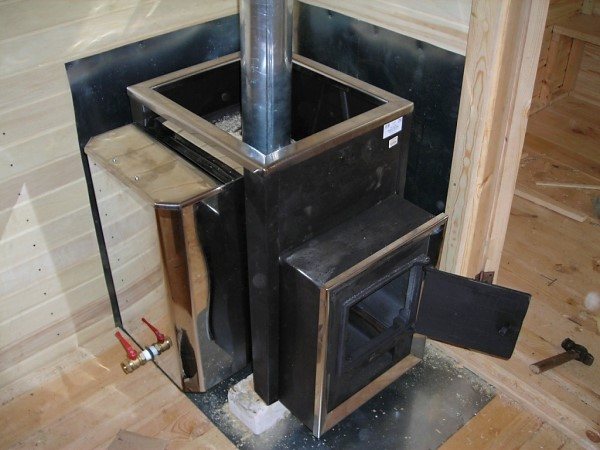
Photo 2. Model of the Rainbow PB-21 stove installed in the bathhouse. The wooden surfaces around are covered with a protective screen.
Next, pay attention to the equipment (built-in or removable tank, its volume). The built-in tank is included and does not require installation. The removable one can be positioned as you wish in a way that is convenient. If the tank is removable, it is possible to purchase one with a larger capacity.
Let's give the country coal
The use of coal for heating a bathhouse is a very delicate, if not scrupulous, issue. On the one hand, coal, especially high-quality anthracite, is a very high-calorie fuel that maintains the temperature inside the coal cake for a long time. In addition, anthracite and semi-anthracite produce relatively few volatile substances during combustion; they form soot plugs in chimneys.
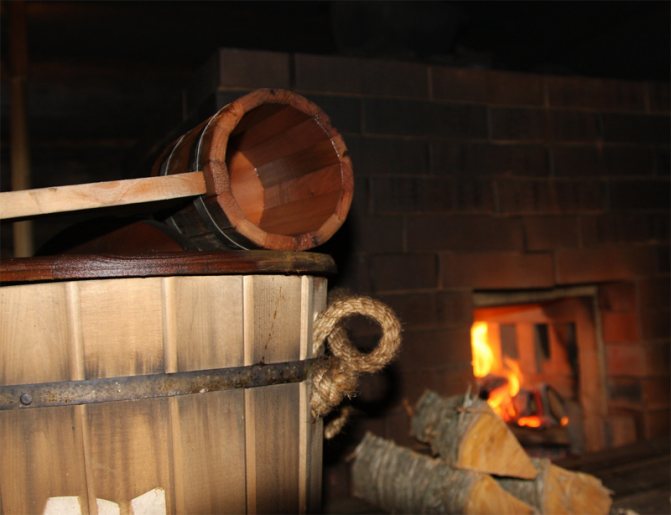
On the other hand, truly high-quality anthracite is not always available and is almost always not cheap. Ordinary gas coals are prone to the formation of flue gases saturated with solid soot particles, which radically pollute smoke exhaust systems.
And finally, the combustion of coal is associated with the formation of a large amount of ash, which requires disposal, and the combustion process itself is accompanied by the characteristic and unpleasant smell of coal tar. In general, coal cannot be classified as an environmentally friendly fuel and therefore, when solving the problem of what is the best way to heat a bathhouse, coal should be considered last.
The dilemma of how to properly heat a bathhouse with a metal stove with coal is in most cases solved in budget establishments that provide bathing services on a commercial basis. Due to their specificity, heating with wood, and of high quality, is quite a costly undertaking, sometimes eating up all the profit.
Lords of Stone and Fire
Now it’s worth considering the algorithm for the problem of how to properly heat a stove. In general, the entire process can be divided into several main stages, such as: preparation, combustion and completion of combustion. Previously, any housewife knew thoroughly how to heat a Russian stove and, most importantly, how to properly heat a Russian stove.
On your marks
At the preparatory stage it is necessary:
- Conduct an external inspection of the stove, ducts and chimneys to ensure there are no visible damages or malfunctions.
- Check traction. To do this, just light a crumpled sheet of paper in the firebox and watch the behavior of the flame. It should steadily deviate deeper into the firebox, towards the smoke channel. It is also useful to cover the ash flap and monitor how the level of natural draft drops by the behavior of the same flame.
- Remove from the pre-furnace space all flammable objects that could serve as a source of ignition near the stove as a result of inadvertent sparks.
- Clean the ash pan and grates from ash to ensure normal air circulation during the combustion process.
- If the furnace design has water boilers and jackets, check that they are at the required level to prevent them from burning out.
- Open the chimney valves and open the ash door.
- Let's check the heater insert. As is known, for normal heat transfer, the ratio of the volume of working stones in the heater in relation to the volume of the steam room should be within 1:50.
We suggest you familiarize yourself with How to properly install penoplex on the wall
Ignition
Now, a few words about the quality of firewood, or more precisely, about its humidity. Firewood, like gunpowder, should always be kept dry. For this purpose, even in the simplest bathhouse design, without a dressing room, a canopy was provided above the entrance for storing clothes and firewood. It is better not to know how to heat a stove with raw wood, since raw wood shoots, smokes and does not burn, or rather, it burns, but poorly.
- We fill the firebox with seed, that is, small firewood, birch bark, wood chips, paper, which ensures reliable ignition.
- As the flame sets the seed and begins to burn confidently, we add small logs “staggered”, that is, leaving free space between them for air circulation. We make sure not to “lock” the flame in the firebox with excessive quantity or size of firewood. At the same time, it is very important not to look through the flame, to prevent the seed from completely burning out.
- At this time, the firebox door can be kept ajar for a better supply of air oxygen to the combustion site.
As the seed burns out and the first load of firewood begins to burn confidently, you can perform the following actions:
- We put standard size firewood into the entire volume of the firebox, but leaving a gap of 200-250 mm to the upper arch of the firebox. Modern science has not yet figured out how to heat a stove with a firebox filled with wood right up to the vault. This rule must be observed throughout the entire process of heating the bath.
- Open the ash door. The firebox door must be tightly closed.
- We monitor the air temperature in the steam room and the water in the boiler, if the stove is equipped with one. Visually monitors the temperature and condition of the stone backfill by its appearance.
Depending on the quality of the stove, the thermal insulation properties of the bathhouse structure and other individual conditions, the time to reach the operating air temperature of 60 degrees Celsius can take about 2-5 hours. Approximately the same algorithm of actions applies to the question of how to properly heat a bathhouse with an iron stove.
Finish of the furnace firing
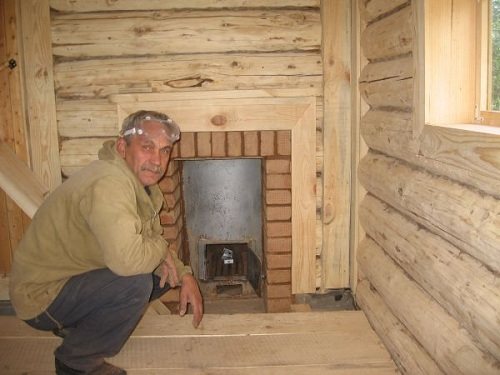
Once the air temperature in the steam room reaches operating levels, the stove can be extinguished. But, as in the question of how to light a stove, there is also a certain algorithm of actions and its own nuances:
- If you are sure that further burning of the stove is inappropriate, then the addition of firewood stops;
- The stove vent is closed and the chimney damper is closed;
- At this time, in conditions of insufficient oxygen supply to the firebox, the formation of very dangerous carbon monoxide is possible - carbon monoxide, the insidiousness of which lies in its lack of color and odor.
- Visually inspect the color of the stone backfill in the heater again;
- The bathhouse is thoroughly ventilated and steamed with the first steam.
| Wood name | Specific heat of combustion, kW h/kg | Nominal combustion heat for dry firewood at 18% humidity, kWh/cub.m. | Nominal combustion heat for freshly cut firewood at 55% humidity, kWh/m3. |
| Beech | 4,2 | 2200 | 1900 |
| Oak | 4,2 | 2100 | 1850 |
| Ash | 4,2 | 2100 | 1850 |
| Birch | 4,3 | 1900 | 1670 |
| Elm | 4,1 | 1900 | 1670 |
| Maple | 4,1 | 1900 | 1670 |
| Alder | 4,1 | 1500 | 1300 |
| Poplar | 4,1 | 1400 | 1230 |
| Pine | 4,4 | 1500 | 1300 |
How to properly heat a sauna - tips for beginners
Even in ancient times, people used water and steam for health procedures. This is mentioned in many historical sources. But even today the popularity of the bathhouse is only increasing.
Shall we flood the bathhouse?
Bath procedures represent a whole ritual for which you need to carefully prepare. Every steam fan should know how to properly heat a sauna. To do this, you will have to understand some of the intricacies of this art.
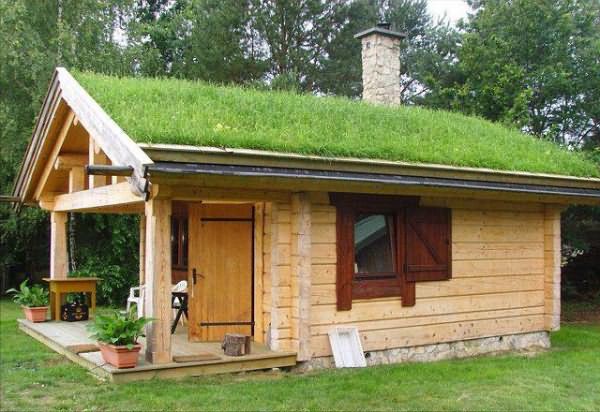
Before carrying out the procedures, of course, it is necessary to heat the room well. Modern people use various equipment: electric or gas boilers. But real lovers only value wood heating. After all, it is the smell of firewood that gives that unusual atmosphere, the bathhouse spirit. How to heat a Russian bathhouse? This is an entire art that can be mastered with some effort. Well, practice will help you quickly master all the tricks.
Classic bath
The classic Russian bathhouse is most often heated by wood stoves. They may differ in design from each other in some way, but the principle of operation is the same. It itself is built in a separate room, or it can be placed in some large building. Inside it has at least two parts: the steam room itself and the dressing room. Fans of contrasting procedures, if space allows, also build a swimming pool. Walls are best built from wood. Old Russian baths were always built like a log hut, only the windows and doors were cut down to a small size, this was done so that the heat inside would be better retained. Modern buildings are built from different building materials; their choice on the market is now huge. But in any case, the interior decoration should only be made of natural wood. At high temperatures and humidity, the use of synthetics is strictly prohibited.
Sauna stove design
To ensure the correct temperature and humidity conditions, the water heating furnace is placed in such a way that all rooms are heated at the same time. Knowing how to heat a stove in a bathhouse, what its arrangement is, you can easily create the desired microclimate in the room.
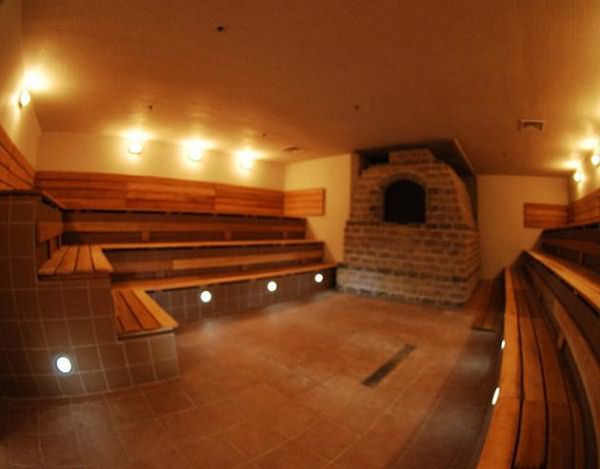
A classic oven is built according to certain rules.
- In the lower part there is a door and a vent, from here air is supplied to the area where the fuel burns.
- The grate is a massive steel or cast iron grate on which firewood is stacked.
- The ash zone, or combustion chamber, is the main unit of the furnace, where complete combustion of fuel and heat generation occurs.
- On top there is a steam heater and a steel or stainless steel water tank.
- Removal of combustion products from the ash zone occurs through a chimney. To regulate draft, dampers are installed in it.
The operating principles of a sauna stove are quite simple, but not everyone can immediately achieve stable combustion. Fuel leaks often occur. How to heat a sauna correctly, what fuel to use? True connoisseurs of such procedures under no circumstances use flammable liquids for ignition.
What kind of wood to heat the bathhouse with?
Fuel (wood) plays the most important role in heating. A lot depends on the rock: how much heat will be released, how long the combustion will be. In addition, the atmosphere created by the unique aroma that appears during the burning of wood is also important.
In Russia, birch logs are considered traditional for baths. Some also use coniferous wood, but it is worth considering that such firewood burns out very quickly. Hardwoods (ash, oak) have excellent heat transfer. But these rocks are valuable, and drowning them will be quite expensive.
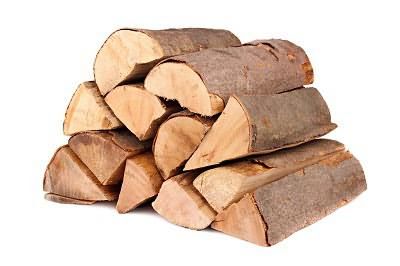
Firewood storage
It is necessary to prepare firewood in advance, because after chopping and subsequent drying, it dries completely after a year. Before heating the sauna, you need to thoroughly check all the firewood; it must be absolutely dry. When wet logs are burned, heat transfer is minimal, and a lot of wet steam is formed, which immediately cools the channels in the stove, and condensation settles on the cold walls. This can render the entire chimney unusable.
The operation of the stove and its efficiency depend entirely on the quality of the firewood. They must be dry and also have the same size, their thickness should be approximately 6-8 cm. At the very beginning, it is better to use small dry pieces for kindling; shavings, wood chips, birch bark or paper are suitable for initial ignition. Never use kerosene or gasoline.
Firewood should be stored in dry, ventilated areas or under sheds. In the cold season, before lighting the bathhouse, it is best to bring firewood into the room to warm it up.
Preparing the premises
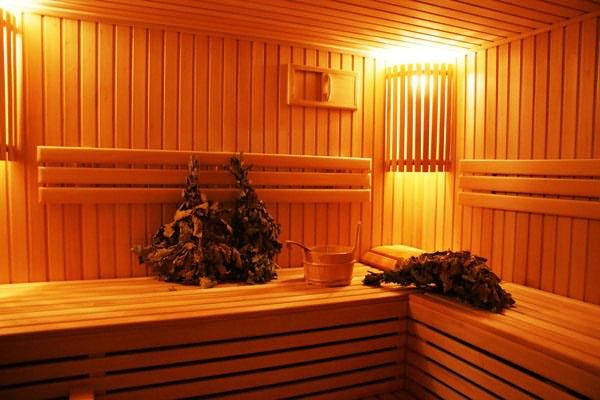
Before heating the bathhouse, it is necessary to prepare the room. Put the walls and shelves in order, wash them, ventilate the rooms. Fresh air and a clean environment will create the best conditions for health procedures. The stones from the steam room should be rinsed in clean water and put back in the same order. The heating container must be rinsed thoroughly and filled with fresh water. The water in the tanks and pool is also renewed. In the dressing room, prepare clean towels, sheets, and other necessary accessories. Also take care of drinks in advance; these can be various herbal infusions, tea, kvass, or plain water. Drinking alcoholic beverages during procedures is strictly prohibited; this can have a detrimental effect on overall well-being.
Kindling the stove
In order to learn how to properly heat a bathhouse, you need to study some nuances that will help you master this simple science. First of all, it should be noted that the stove must be in good condition; only dry fuel should be used for kindling.
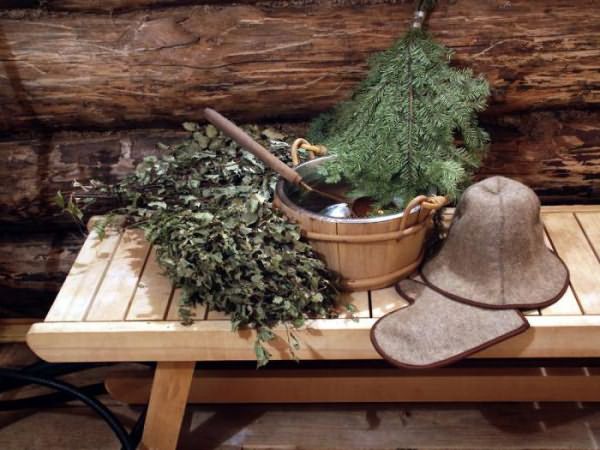
First you need to clean the ash pit and grate from ash. The chimney dampers must be fully opened. In the combustion chamber in the form of a hut, place small wood chips, compressed paper, and place four medium-sized logs on top, but so that they do not touch. Light the paper and close the door to prevent smoke from pouring into the room.
Gradually, larger chips and small logs are added to the seed fire. Remember that the vent must be completely open at this time; the flow of oxygen allows the flame to flare up better. Gradually the chimney will warm up and a stable draft will be created.
Use a poker to thoroughly smooth out the burnt coals. Fill the firebox one-third full with dry logs. At the initial stage, firewood is placed carefully so as not to extinguish the flame. When a characteristic hum appears, it means that the stove has warmed up and requires a sufficient amount of fuel. New logs need to be placed closer to the door. Do not let the fire go out until the room and the water in the boiler are completely heated.
After about two hours, the coals inside will turn scarlet. It's time to push the pipe valve halfway. It can be closed completely only when the carbon monoxide has evaporated. How can this be determined? Turn the coals with a poker; there should be no blue flames slipping anywhere, this is carbon monoxide, which is dangerous not only to health, but also to life.
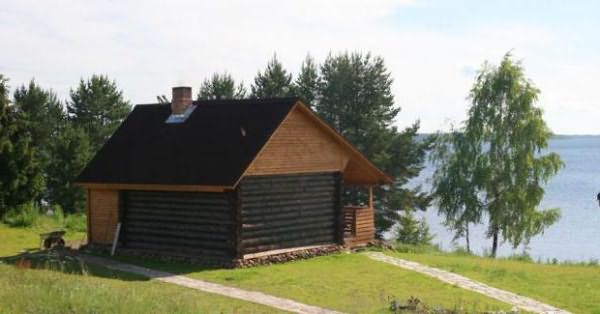
Follow the rules of kindling
Every fan of the Russian bath simply needs to learn the correct kindling and become a lover of this process. After just a few sessions, an understanding of the matter and experience will come. But it is worth noting that learning how to properly heat a sauna is not all. During the process, be sure to monitor the stove. In order to reduce draft in a heated chimney, you need to close the dampers in time. The blower door also needs to be closed, but not completely. In order for the heat in the firebox to be uniform, firewood must be supplied on time, as needed. After the procedures are completed, the oven must cool completely. After this, you need to remove the ash from it and clean the room. Let your bathhouse rest until the next session. Enjoy Your Bath!
fb.ru>
